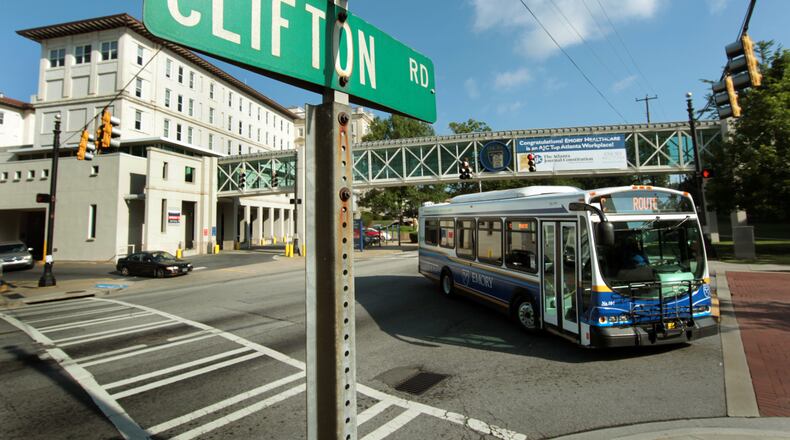MARTA is reconsidering plans for light rail on another key Atlanta transit corridor — the latest indication that the agency’s plans for a major rail expansion may not come to pass.
The agency is studying bus rapid transit as well as rail for the proposed Clifton Corridor, which would link Lindbergh station to Emory University and the U.S. Centers for Disease Control and Prevention. MARTA plans to select a preferred alternative by October, interim CEO Collie Greenwood told the Atlanta City Council’s transportation committee Wednesday.
In February, MARTA announced it would recommend bus rapid transit instead of light rail for the Campbellton Road line in southwest Atlanta. And a recent preliminary report on a section of the Atlanta Beltline found light rail would cost far more than expected.
Betty Willis, senior associate vice president at Emory, said the university is open to either bus rapid transit or light rail.
“Both of them are transit that will open up access to thousands of jobs at Emory and the CDC,” Willis said.
But some City Council members continue to push back on MARTA’s shifting plans.
“I thought my house was going to be red, and you come back to us saying my house is going to be yellow,” Councilman Antonio Lewis told Greenwood.
Greenwood said plans for rail were always subject to change as MARTA studies various routes. He said final decisions will be made in cooperation with elected officials.
“I couldn’t stand here and agree there was a promise that it would be rail,” he said.
The debate comes as MARTA and other agencies embrace rapid buses — a form of transit found elsewhere but not yet in metro Atlanta. Bus rapid transit mimics rail lines, with transit stations, exclusive lanes and other technology designed to keep passengers moving.
MARTA already is preparing to build the region’s first bus rapid transit line along Hank Aaron Drive and Capitol Avenue in Atlanta. MARTA and other agencies plan similar lines along the top end of the Perimeter and in Clayton and Gwinnett counties.
MARTA’s Atlanta expansion was made possible when city voters approved a transit sales tax in 2016. Two years later, MARTA approved a list of projects the new tax would pay for, and in 2019 it approved a timeline to develop the projects.
The $2.7 billion, 40-year expansion plan included 13 miles of bus rapid transit, which operates in exclusive lanes and includes other features that make it faster than regular local bus service.
The plan also includes other bus enhancements, new transit stations and other improvements. But the centerpiece of the plan was 29 miles of light rail stretching from the Emory/CDC area to Lindbergh, along part of the Beltline loop and down to southwest Atlanta along Campbellton Road.
Now MARTA is conducting detailed studies of various projects in preparation for requesting crucial federal funding. And its initial plans for light rail appear to be changing.
The Campbellton Road line is the furthest along. In February, MARTA said bus rapid transit makes sense for the corridor because it’s less expensive, can be built faster and would require less right of way.
The announcement sparked a backlash among some City Council members and neighborhood residents, and in recent weeks MARTA has launched a campaign to educate residents about the benefits of bus rapid transit. The MARTA board of directors is expected to make a final decision soon.
MARTA also recently completed a preliminary engineering analysis of two sections of the proposed Atlanta Beltline transit loop. The study found light rail on the northeast section would cost twice as much as originally projected, and MARTA’s chief of capital programs suggested rail could be too expensive. Many Beltline transit advocates want light rail.
MARTA plans more detailed Beltline studies over the next two years before it makes a final decision.
On Wednesday, Greenwood said MARTA is considering four bus rapid transit and six light-rail alignments along the Clifton Corridor. Emory officials have long sought a transit line to serve one of the largest employment centers in the region.
MARTA plans to narrow the list of options to the top three alternatives by August and make a final decision in October. Willis said Emory will accept whichever transit mode MARTA recommends.
Greenwood said MARTA has been discussing the alternatives with community representatives, and it plans to seek broader community input later this spring. City Councilman Alex Wan, who represents the area, said constituents have been receptive to bus rapid transit. But he encouraged MARTA to keep them well informed.
“We don’t want to surprise everyone at the end,” Wan said.
What is bus rapid transit?
Bus rapid transit mimics rail lines, with limited stops and boarding at transit stations. It operates in exclusive lanes and uses other features to move faster than regular local bus service. Supporters say it’s less expensive and quicker to build than rail transit. Critics say bus rapid transit service is not as fast or as permanent as rail, and they question whether it can have the same economic impact.
About the Author
The Latest
Featured



